What is a product portfolio?
How can I build my own if I’m an aspiring product manager?
ll it help me get a job, even without much experience or technical skills?
If you’ve asked yourself any of these (or panic-Googled them at 1:47 a.m. before a job application deadline), you’re in good company. We get these questions all the time– from fresh grads figuring out their first career step, to practising PMs levelling up, to folks making bold career switches into product.
To start with, here is the answer to your last question: No, you don’t need to be a coding wizard or have years of experience to build a great product portfolio. What you do need is a clear structure, the right tools, and the mindset to showcase your thinking and problem-solving skills.
And that’s exactly what we’re going to do here.
Honestly, calling this “just a blog” sounds a bit of an understatement; it’s more like your A-to-Z playbook for building a product manager portfolio from scratch (and doing it in a way that gets noticed). But we really would not wanna hype it too much before we deliver.
Update: We have covered this post in one of our live sessions at HelloPM’s Product Management Bootcamp. Here is the video 👇🏽
What Is a Product Manager Portfolio?
A product manager’s portfolio is a digital collection of their product thinking, problem-solving, user-centric mindset, and communication skills. Unlike a designer or developer portfolio, a PM portfolio isn’t about visuals or code-it’s about your approach to building products and solving problems.
Your portfolio can include:
- Case studies of product ideas or side projects
- Redesign breakdowns of existing apps
- User research you conducted
- Wireframes, feature specs, product roadmaps
- Reflections from product hackathons or PM courses
We will talk about this in detail in the sections below!
Why is a Product Manager Portfolio Important for an Aspiring PM (Key Benefits)
As with everything in product management, we will start our guide with a strong Why?
Why at all should you invest time and effort into creating a portfolio?
Let me be clear from the start that creating your portfolio is not going to be an easy task. You’ll have to commit time, and substantial efforts to create a remarkable portfolio.
Hence having a clear why will help you keep the motivation while creating a remarkable portfolio.
Here are three reasons why you should absolutely create a portfolio if you are an aspiring product manager.
- 10x your learning: Doing is the most effective form of learning. The act of creating a portfolio, helps you transform your learnings into a tangible outcome.
- Collect your learnings: A portfolio can also be used to collect your most important learnings through projects. Consider as a collection of your best product work, which you can refer to all along with your professional career.
- Get a job or internship: You can showcase your portfolio to your prospective employers as evidence of your product skills. This is particularly helpful for people who are looking to transition into product management and do not have any formal work experience to showcase their skills.
Key Takeaway
- Accelerates learning: Doing > reading.
- Captures and organizes your best work for long-term reference.
Boosts credibility for job/internship applications, especially with no formal PM experience.
Before we move forward, here are a few examples of portfolios:
Real-Life Product Manager Portfolio Examples
This is still a work-in-progress section. I will keep updating as I come across more portfolio examples. Feel free to send your recommendations!
| Portfolio | Remarks |
| Anish’s Portfolio (HelloPM Cohort Member) | This portfolio has a lot of personality to it. Like an extended resume, has case studies, skills, and career background. |
| Surabhi’s Portfolio (HelloPM Cohort Member) | Easy to navigate and concise. Things that generally get lost in a resume like projects & personal story, are highlighted well. |
| Aparna’s Portfolio (HelloPM Cohort Member) | Detailed, long portfolio. Aparna has included her assignment submissions from the HelloPM cohort, which might help prospective employers understand her product skills. |
| Sugat’s Portfolio (Product Manager – Meta, HelloPM Mentor) | Sugat’s breakdown case study of CRED, helped him lead many interviews during his job hunt. An interesting example of articulating a product improvement. |
| Garett’s Portfolio (Product Designer at GoLoop & Canva) | This is like an ideal portfolio, Garett has included real examples from his work as a product leader/designer. Including the whole process, he and his team has gone through to create products. |
| Simon Pan (Product Designer at Google) | In another compelling portfolio, Simon has included real examples from his work as a product leader/designer at leading companies. Including the operational nuances of going through a product development life cycle. |
There are some more, you should definitely check out
- Mark Progano’s Product Portfolio
- Elezea’s Product Portfolio
- Chandan’s Portfolio (Participant in 2nd cohort)
- Prasad’s Portfolio
- Chetan’s features section on LinkedIn. (Participant in 5th cohort).
Key Components of a Strong Product Manager Portfolio
We often get asked, What should we include in our Product Management Portfolio, and there is no single simple answer.
Product portfolios come in different shapes and sizes; however, the aim of all of them is to showcase your product skills.
As per the ideal definition of a portfolio, it should contain all the product work that you have done in the past. For example, in his portfolio, Garett has mentioned about YouTube Mockup Tool, Create with Google and other projects he has worked on as a part of his job.
However, including your past work at a PM, job might not be enough for building a strong portfolio:
- You might be an aspiring product manager, so you don’t have any real work to show yet.
- Although you have been a product manager, you didn’t work on something that you could proudly showcase (internal products, execution work, the product didn’t launch, etc.)
- Your employer might not allow you to share the work publicly.
So while it is ideal to include your past work, it’s practical to consider your portfolio as a repository of your learnings around product management.
Things to Include in Your Product Management Portfolio
Listed in decreasing order of effectiveness and increasing order of ease of creation.
A great portfolio contains a mix of different project types. While many people simply publish their knowledge of product management concepts in a blog post and call it a portfolio, this is far less impactful compared to showcasing tangible product work. The closer you can get to real, structured, outcome-driven examples, the stronger your portfolio will be.
1. Past Product Work (Most Credible & Effortful)
This is the most credible and effortful work that you can add to your product portfolio.
People who have worked in product or adjacent roles can showcase their process of building a product, improving a feature, or any part of the product management cycle that they have participated in.
Focus on articulating your process of finding and validating the problem, and showcase the artifacts that you created while building the product.
Focus on articulating your process basen on these pointers:
- What user problem were you solving? How did you arrive at it? How was it validated?
- How did this align with the business goals?
- How did you come up with solutions, and their prioritization? Briefly talk about other solutions that were close but weren’t picked.
- How did you release it to the audience?
- How have you collaborated with different stakeholders?
- How did you measure success? What happened after the release?
Answering these questions on your past work will give your portfolio work a decent structure.
Bonus- Even if you didn’t work as a product manager directly but worked in an adjacent role like sales, marketing, design, development, etc, you can still ask these questions to your product managers to learn in detail. This will help you understand the product process well.
While mentioning this in your portfolio, don’t forget to mention your exact contribution.
2. Product Analysis & Comparison
If you don’t have past product work, one of the best portfolio additions is analyzing existing products — either a single product or comparing multiple products in the same category.
Option A: Single Product Deep Dive
Pick a product from the Play Store, App Store, Product Hunt, or even the company you’re applying, and conduct an exhausting product analysis.
Key elements to include in your analysis:
1. What problem(s) does the product solves?
2. Who is facing this problem (user persona)?
3. What the user journey looks like?
4. Who are the competitors and how are they solving this problem?
5. What is unique about this product?
6. How does this makes money?
Pro Tip- To get brownie points, you can talk to actual users to answer the above questions.
Example Inspiration- Here are a few similar analyses for your inspiration:
1. Mansi’s & Kirti’s analysis and suggestions of Quora
2. Chetan‘s analysis and suggestions for ProductHunt.
(Chetan, Mansi, and Kirti are participants of our product management bootcamp) .
Once done, you can then include this analysis in your portfolio webpage.
Option B: Category-Wide Product Comparisons
Instead of a single product, pick a product category (e.g., food delivery apps) and compare multiple products within it (e.g., Swiggy vs. Zomato).
For example, you can choose the category to be food delivery apps, and can now compare Swiggy and Zomato side by side.
This will help you understand market dynamics, user needs, and differentiating factors among sumilar products.
In this analysis you can explore things like:
1. Dynamics of this market. How big is the market, and how is it growing?
2. User insights: Who are the popular users in this category, and what problems got them to use these products?
3. What are the different products in this category? Can you further categorize them?
4. Create a feature comparison and pricing comparison chart.
5. What differentiates one product from the other?
6. If users have to choose one among them, which one would they choose and why?
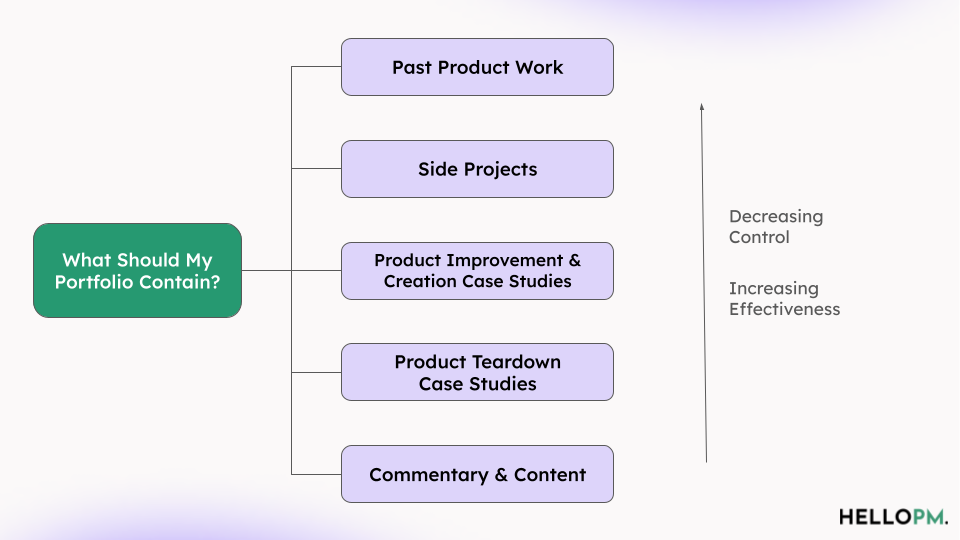
You should read reviews about the products from sites such as Quora, Reddit, G2Crowd, TrustPilot, etc. A list of websites that can help you with your industry research at given in the footnotes of this article.
3. Improving a product
Here you can go a step ahead, and start suggesting the improvements in the popular products. You can choose a product of your choice and follow the product thinking framework to suggest some improvements.
As the concluding step, you will also use some design tools like Figma, to actually showcase your improvements as wireframes or high fidelity designs.
Here is the framework product managers generally follow to improve any product:
1. Find the users who might be using the product (user persona).
2. Find their problems (these problems could be inside the product or might be related to the core jobs to be done for the users).
3. Prioritize the problems based on the estimated impact of solving them.
4. Come up with multiple solutions for the top problems.
5. Prioritize the solutions by using the simple Impact v/s Effort comparison.
6. For the top prioritized solution, create the user flow and design (wireframes or actual)
7. Decide the metrics which you would measure to find out the success of this improvement.
You can articulate these steps in your analysis and add them to your portfolio.
These kinds of analyses could become a very strong talking point in your product interviews.
4. Problem-to-Solution: Product Design->No Code Builts->Launch
In this kind of portfolio item, you start with a problem and come up with your solutions (in the form of products) to solve them.
For instance, take this problem statement- Many people face the problem of forgetting what they read. To solve this, we could explore multiple solutions –
- A system for timely revision using flashcards
- Automated emails sent at scheduled intervals with content to review.
- A browser extension that highlights and resurfaces important notes at intervals
Now, put on your product hat and identify problems you or people around you face regularly, then design solutions to address them.
- You can stop at creating wireframes or designs that demonstrate your product thinking,
Or take it a step further by using a no-code tool to actually bring your idea to life.
Here is the step by step way to execute this process-
Step 1: Identify the Problem
- In our case the problem is –
Many people face the problem of forgetting what they read. So first thing is , we need to look for pain points in your own life or in communities you’re part of. - Talk to potential users to understand how widespread the problem is.
- Estimate potential demand using a quick guesstimate or market sizing approach.
Step 2: Brainstorm Solutions
For the problem, we already discussed potential solutions, let me reiterate for better clarity:
- A system for timely revision using flashcards
- Automated emails sent at scheduled intervals with content to review
- A browser extension that highlights and resurfaces important notes at intervals
Step 3: Choose & Prioritize the Best Solution
- Use an Impact vs. Effort matrix to pick the most feasible, high-value idea.
- The idea here is to consider the solution which solves the problem most effectively for the target audience.
Step 4: Design the Product
- Create a user flow to show the journey from entry to goal completion.
- Build wireframes or high-fidelity designs using tools such as:
| Figma | A powerful tool to create any kind of design work from wireframes to full-fledged dev-ready designs. |
| Balsamiq | The go-to tool for creating wireframes. |
| Whimsical | Create flow diagrams, wireframes, and lot more with this easy-to use tool. |
| Adobe XD | A powerful tool from adobe to create any kind of design work from wireframes to full-fledged dev-ready designs. |
| Canva | A beginner-friendly tool to create basic designs and presentations. |
Once your design is ready, you can stop here and present it in your portfolio or take it a step further by building a functional version using no-code tools.
Step 5: (Optional but Highly Impactful) Build It Using No-Code Tools
This optional build step can significantly increase the impact of your portfolio project, as it transforms your work from a concept on paper to a tangible product that people can use. It also shows recruiters you can ship quickly and turn ideas into reality without depending on a development team.
Popular No-Code Tools by Use Case:
| Use Case | No Code Tool | Quick Start |
| Create a website | WebFlow | Tutorial |
| Wix | Tutorial | |
| Cardd | Tutorial | |
| Create Web Apps with Data | Xano | Tutorial |
| Notion | Tutorial | |
| Airtable | Tutorial | |
| Create Mobile App | Glide | Tutorial |
| Bravo | Tutorial | |
| Bubble | Tutorial | |
| Automation & Integrations | Integromat | Tutorial |
| Zapier | Tutorial | |
| IFTTT | Tutorial |
Inspire yourself: Here are a few products built with no-code tools.
Step 6- Launch Your Project & Document the Journey (Again, Optional!)
This is taking your product journey to a whole new level.
By actually launching and taking your product to the market you will understand integral concepts of product management like customer development, experimentation, creating a go-to-market strategy, etc.
How to launch effectively:
- Identify your first users (could be the people you interviewed in the discovery stage).
- Pick your launch platforms: You can launch your product on Producthunt, Reddit, BetaList, or even on your personal social network profile on LinkedIn, Twitter (or even your WhatsApp status update)
- Collect feedback and iterate — note down what worked and what didn’t.
- Document your journey with posts, screenshots, and metrics to add a proof layer to your portfolio.
Remember, Launching doesn’t mean “perfect” — even a small, scrappy launch shows courage, adaptability, and a learning mindset.
A Few resources that can help you in this journey:
- Read inspiring stories from solopreneurs creating their products.
- Follow the buildinpublic hashtag on Twitter.
- Jump on these subreddits
Make sure you are connecting with the right people in your journey to grow your network and learnings.
5. Bonus- Commentary & Content Creation (Lowest Effort)
This one is like a low-hanging fruit that might not be the juiciest but still worth plucking.
Crafting thought leadership content won’t be as impactful as above, but it can still add value.
- Blog posts or LinkedIn articles on PM concepts, frameworks, and industry trends
- Reflections on your own projects
- Case breakdowns of well-known products
This one is a supplementary, like a croissant to your tea, it can be added, but definitely isn’t the main highlight of your portfolio.
6. What does Ankit recommend?
For me, a great portfolio always has a healthy mix- at least three or four solid pieces of work. If I have to remodel my portfolio, I’d go with past product work to show credibility, a sharp product improvement case to showcase thinking, and a side project or no-code build. Blog writings as an add-on are good, but these three really make the cut”- Ankit Shukla
Key Takeaway- A strong PM portfolio spotlights past product work with full lifecycle and clear metrics, adds product analyses or category comparisons to show structured thinking, includes product improvement projects with problem selection, prioritization, design, and success measures, and features problem-to-solution builds from idea to flows and wireframes, optionally shipped with no code. As a light add-on, include thoughtful blogs or case breakdowns to show your point of view.
How to Create a Product Manager Portfolio (Beginner Friendly Step-by-Step Guide)
Step 1: Choose Your Platform
- Goal: Pick a home for your portfolio that aligns with your target audience.
- You can choose from following Options:
- Notion – Quick setup, flexible templates, easy to update.
- WordPress/Wix/Squarespace – Branded personal websites with custom domains.
- Medium/Substack – Ideal for long-form case studies and thought leadership.
- Behance/Dribbble – If targeting design-heavy PM roles.
- The important thing here is to make sure that your portfolio is mobile-friendly, loads fast, and has clear navigation.
Step 2: Pick Your Best 3–5 Projects
- Why: Quality > Quantity. Recruiters rarely read more than 3–4 in detail.
- Selection criteria: Choose projects that:
- Show a range of PM skills (research, ideation, execution).
- Are measurable with clear before/after impact.
- Relate to your target industry or role.
We already talked about the different kinds of key elements that you can add in your portfolio to showcase skills and experience.
Step 3: Create a Storytelling Framework
- Why: Portfolios without a narrative feel like random screenshots.
- Recommended format for each project:
- Problem Statement – What problem were you solving and why it mattered?
- Research & Insights – How you understood user needs (surveys, data analysis).
- Solution & Process – Wireframes, product specs, MVP builds.
- Impact & Metrics – Quantify outcomes (e.g., reduced churn by 12%).
- Reflection – Lessons learned, trade-offs made, and what you’d improve.
Step 4: Add Visuals & Metrics
- Visuals: Screenshots, wireframes, journey maps, charts, dashboards.
- Metrics:
- % improvement in KPIs.
- Conversion rates, retention %, churn reduction.
- Time saved or revenue potential generated.
- Add visuals with “Before vs After” visuals for stronger impact.
Step 5: Make It SEO & Recruiter-Friendly
- Use clear section headers like “Case Study: Improving Onboarding Flow for XYZ App.”
- Include keywords relevant to your target role (e.g., “product roadmap,” “feature prioritization,” “A/B testing”).
- Add a short bio + professional headshot on the homepage.
- Include contact options: LinkedIn, email, and optional resume download.
Step 6: Update & Refine Regularly
- Treat it as a living document – add new projects and update outcomes.
- Audit for relevance every 3–6 months.
- Replace outdated mockups with more polished designs as you grow.
- Ask mentors or PM peers for feedback.
Key Takeaway
Choose a mobile friendly platform like Notion or WordPress, pick 3 to 5 projects that show range and measurable impact, tell each one with a clear arc of Problem Research Solution Impact Reflection, add strong visuals and metrics for credibility, make the site easy to find and skim with keywords and clean navigation, and keep it fresh by updating it regularly.
Popular Tools & Platforms to Create your Product Portfolio
There are many platforms and tools to create your portfolio, which can feel overwhelming. Some people even use their social media profiles as portfolios, which is perfectly fine! The key is to start choosing a tool and sticking with it.
Recommended Product Management Portfolio Tools & Platforms
| Tool | Description | Pros | Cons |
| Notion | Easy to start, highly customizable wiki-style pages | No setup, shareable links, flexible content | Limited SEO discoverability |
| WordPress | Beginner-friendly CMS with many themes | SEO-friendly, professional look, full control (self-hosted) | Hosting costs and setup needed for self-hosted version |
| Medium | Great for publishing case studies and articles | SEO-friendly, built-in audience | Some content behind paywalls, less portfolio customization |
| Portfolio platforms (Behance, Dribbble, UXFolio) | Originally for designers but usable by PMs for case studies, wireframes | Visual presentation, community exposure | Less suited for product management storytelling |
Secondary Resources to Make Your Product Portfolio Shine
Here are some extra tools to help create polished presentations, visuals, and documentation:
| Use Case | Tools |
| Presentations | Google Slides Templates, Canva, Figma |
| Icons & Design Elements | UnDraw, Icons8, Figma Community |
| Images & Videos | Pexels, FreePik, Unsplash |
| Mockups & Screenshots | Dimmy. club, Screen.Traction.One |
| Video & Screen Recording | Loom, Jitter |
Key Takeaway
Use Notion for quick setup, WordPress for professional sites, Medium for long form content, and Behance or Dribble for visual heavy portfolios, choosing based on ease of use, SEO, and audience, and polish the presentation with tools for slides, icons, images, mockups, and screen recordings such as Canva, Figma, and Loom.
How to get a Product Management Job through a Product Portfolio?
Your product portfolio can give assurance to your prospective employers that you have an understanding of how products are synthesized and shows your passion for product management.
Here are few ways to get your portfolio across the employers and the public:
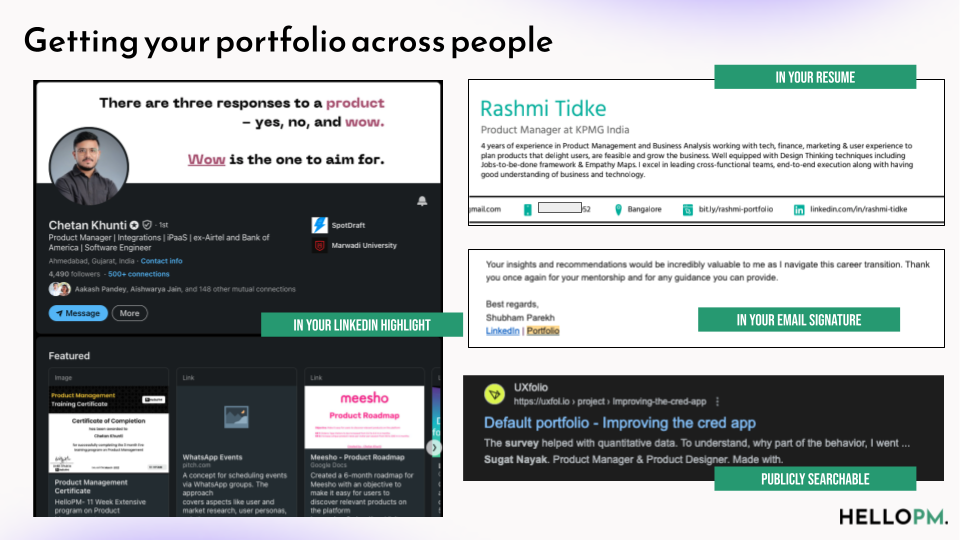
You can mention your portfolio in the resume itself. You can also send it to some decision-makers or product managers in the companies you are looking to work with for feedback and input.
In your cover letters, or initial emails to HR/Recruiter/Interviewer you can attach your product portfolio and mention how some of it could be relevant to this organization as well.
You should also actively share your work on social media platforms too. You don’t know when serendipity strikes and you get your future opportunity from one of your portfolio viewers.
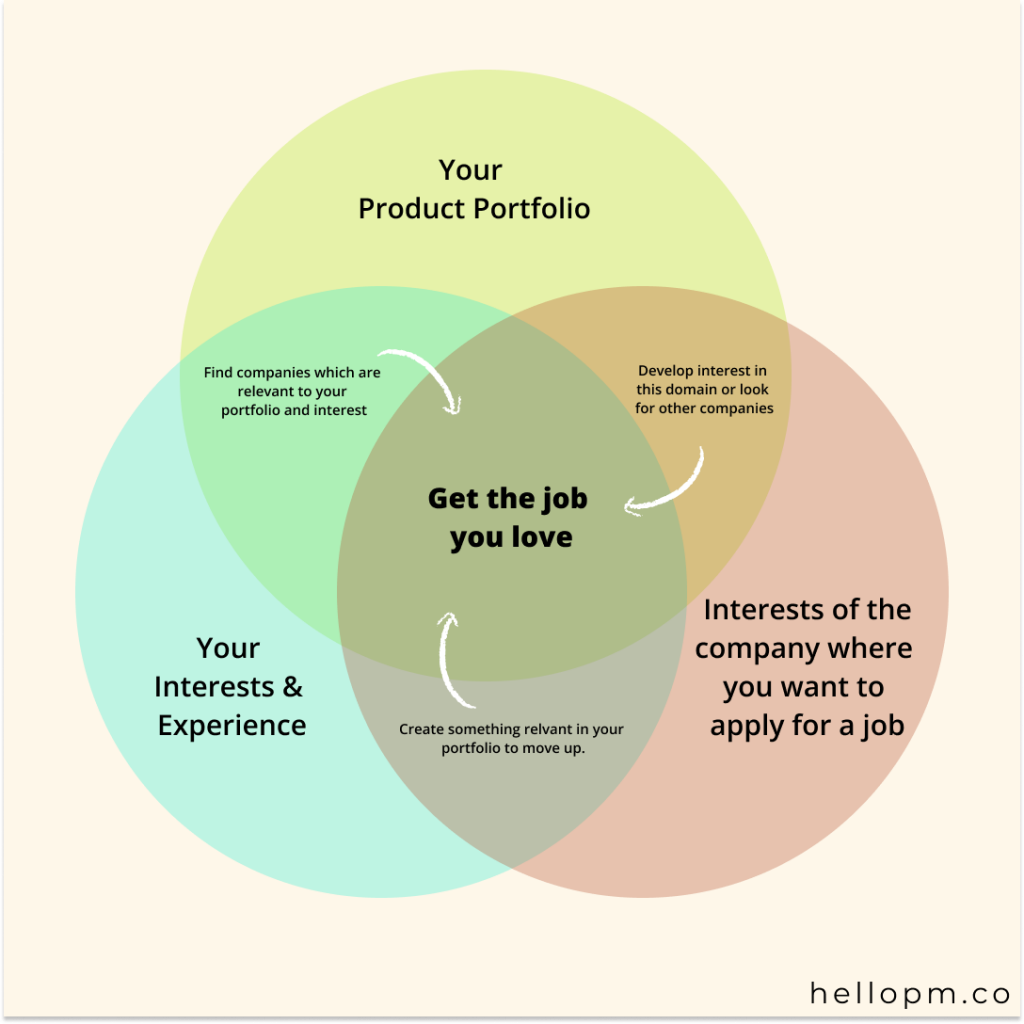
Issues with the product portfolio and work-arounds
One critical challenge when job hunting with a product portfolio is that most interviewers, hiring managers, and decision-makers simply don’t have the time to review it in detail. With hundreds of applications per role and 20% of candidates attaching some form of portfolio, yours can easily get overlooked unless it instantly feels relevant and valuable to them.
Workarounds That Actually Work
- Target domain-relevant companies – Apply to companies in the same industry or solving problems you’ve already covered in your portfolio. Mention this alignment clearly in your resume or intro email so they can’t miss the connection.
- Proactive, company-specific case studies – Build portfolio items directly related to the company’s product, feature, or problem area. Several HelloPM candidates have created teardown case studies for their dream companies and shared them proactively, leading to interview calls and even offers.
These approaches increase the likelihood that your portfolio will be opened because it speaks directly to something the company is already working on.
Common Mistakes to Avoid While Creating Your Product Management Portfolio
- Overloading your portfolio with too many projects instead of 3–5 strong, relevant ones.
- Focusing only on design instead of process + impact + metrics.
- Using vague language without quantified results.
- Keeping it generic instead of tailoring for specific companies or roles.
- Neglecting updates making your portfolio look outdated.
Final Checklist for Your Product Management Portfolio
Before sending your portfolio to a recruiter or hiring manager, make sure it has:
- 3–5 high-quality, outcome-driven projects.
- Clear storytelling: Problem → Research → Solution → Impact.
- Quantified metrics showing measurable results.
- A clean, mobile-friendly design with easy navigation.
- A tailored section for the company or domain you’re applying to.
Key Takeaway
To turn your portfolio into interviews and offers, place its link in your resume, cover letter, and LinkedIn, share it directly with decision makers while asking for specific feedback, and amplify it on social media and PM communities for visibility. Remember that many recruiters will not review in depth unless your work feels instantly relevant, so create company specific case studies or target companies in domains you already cover to raise the open rate. Avoid the common traps of stuffing in too many projects instead of a few strong ones, focusing on design without explaining process and impact, writing vague narratives without metrics, and letting the site become outdated or generic.
Last Sip of Tea
Don’t create your product manager portfolio just to check off a hiring requirement—see it as your personal lab for exploring ideas, solving problems, and sharpening your product thinking. The real value isn’t just landing the interview, it’s in how the process transforms the way you approach problems, gather insights, and deliver solutions.
While a great product portfolio can help you get the job of your dreams, but that shouldn’t be your only aim. You transform yourself when you take on such challenges. You learn by doing.
Attaching something from one of the best teachers of all time: Richard Feynman

A Little Thank-You Gift for Reading Till the End!
Get Your Portfolio Review
Enough of reading, now go ahead and take action. Pick a product you truly love, write a short blog post about your experience using it, and share your ideas on how it could be even better.
When you’re done, send us a quick DM and we’ll happily share feedback, often within just a few days.
In the end, remember we are all works in progress, and the best stories are the ones we keep writing, refining, and polishing with every step we take.
Happy Product Learning!
Frequently Asked Questions (FAQs)
Absolutely. Recruiters want proof of product thinking, not just titles, a strong portfolio builds trust, gives you real examples for interviews, and can turn cold outreach into warm conversations when shared on LinkedIn, Product Hunt, or PM communities.
It’s a collection of your product work that shows your skills and thinking. It helps you stand out to employers beyond your resume.
Begin by documenting product case studies or side projects. Use easy tools like Notion or WordPress to organize your work.
No, you can focus on research, analysis, and strategy. No-code tools help you create real products without coding.
Yes, it shows practical skills and your ability to take a product to market, which employers love.
Add the link to your resume, cover letter, and LinkedIn. Also, share it on social media and directly with hiring managers.
Notion, WordPress, Medium, Behance, and UXFolio are popular options to showcase your work.
Tailor projects to the company, clearly show your process and impact, and use visuals where possible.
Highlight the most relevant projects and explain their link to the company in your application.
Yes, check portfolios from experienced PMs like Mark Progano and alumni from HelloPM for inspiration.
Footnotes & Additional resources
List of websites for product and market research:
- Long form articles about various India and SEA companies and markets: AJuniorVC
- Solid coverage around finance and economics from India: Finshots
- Resources from Accel India around products and startups: Accel India Blog
- Similar resources from Blume: Blume Blog
- Announcement from RBI (for finance folks): RBI
- Annual reports from public companies in India: LearnStockMarket
- Annual reports from public companies in the US: SEC Filings
List of websites for examples around product case studies:
- Visual break-downs and improvements of various popular apps: Growth.design
- Product case studies from MindTheProduct: MindTheProduct
- Creating case study solutions: AgileInsider
Here are a few more resources for market research:

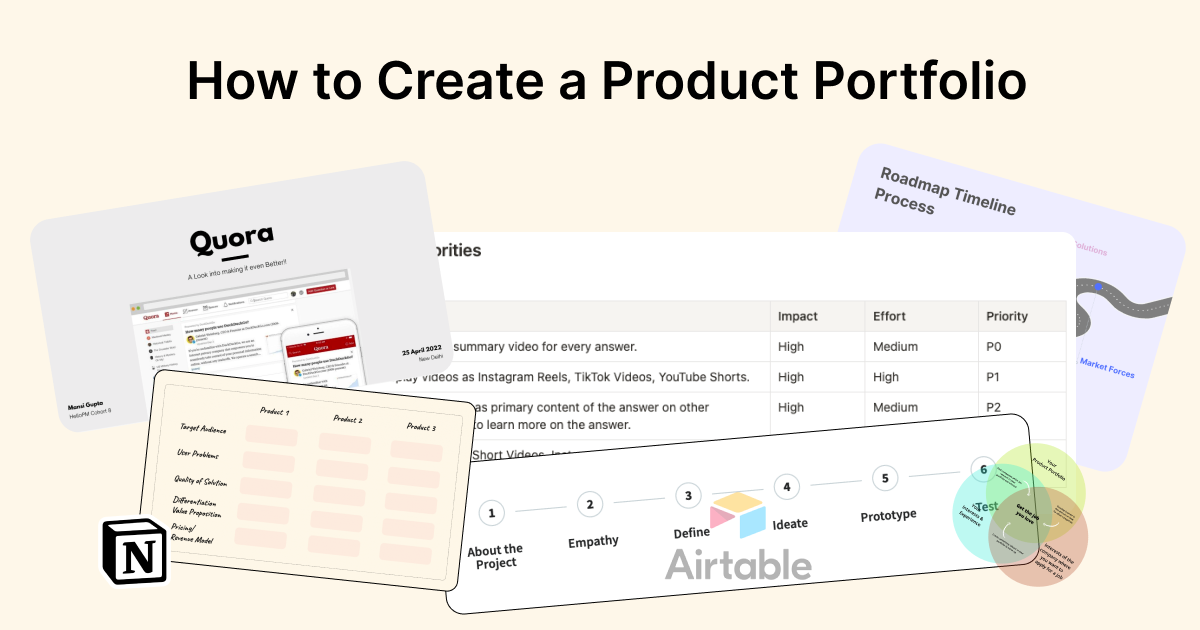
 WATCH HELLOPM COHORT IN ACTION
WATCH HELLOPM COHORT IN ACTION

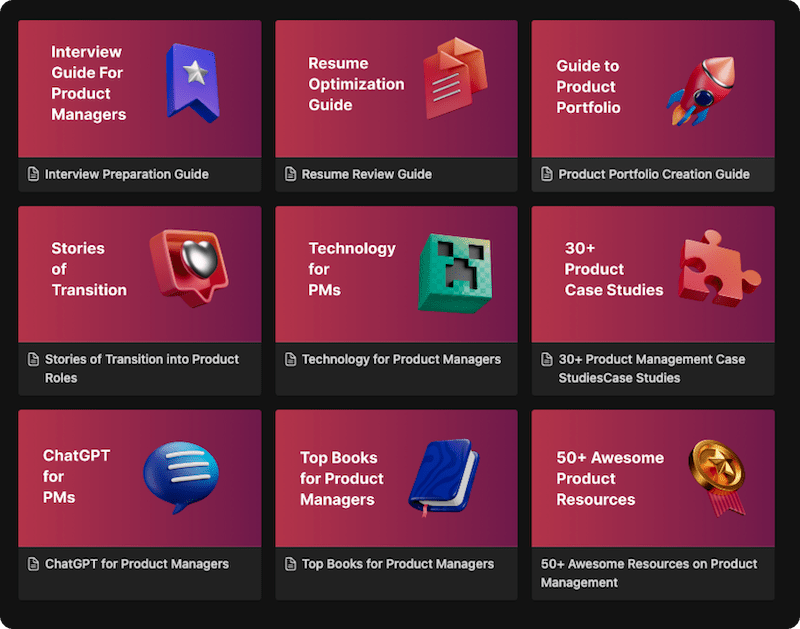

0 thoughts on “How to make a Product Manager Portfolio?”
Comments are closed.